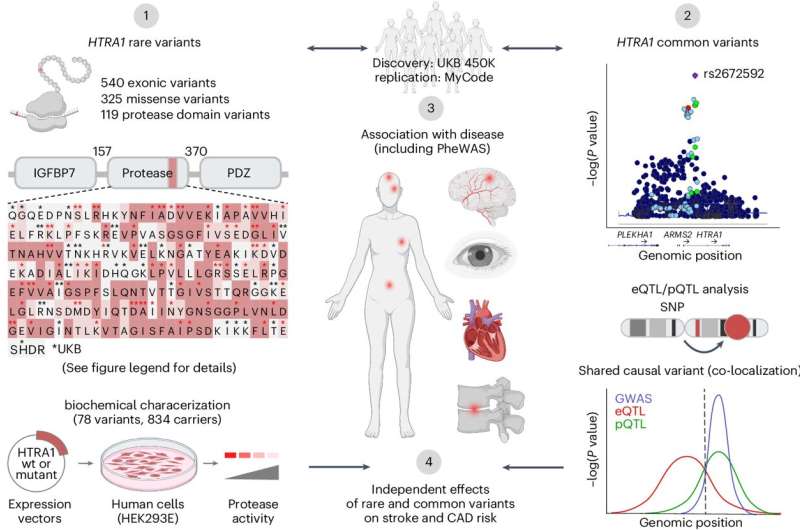This article has been reviewed according to Science X's editorial process and policies. Editors have highlighted the following attributes while ensuring the content's credibility:
fact-checked
peer-reviewed publication
trusted source
proofread
Stroke genetics: Independent HTRA1 mechanisms increase risk, shows study

Cardiovascular diseases, including stroke and coronary artery disease are among the leading causes of death worldwide. Classical risk factors include age, personal lifestyle, and pre-existing conditions, but genetic predisposition also plays a role.
"Large-scale genome-wide association studies have identified multiple genes that influence the risk of stroke and cardiovascular disease," says LMU Professor Martin Dichgans. "They have also shown that genetic information can be used to discover potential drug targets for targeted therapies."
The LMU researchers have discovered two independent ways by which genetic variants increase the risk of cardiovascular diseases. The study is published in the journal Nature Cardiovascular Research.
Director of the Institute for Stroke and Dementia Research at LMU University Hospital and scientist in the SyNergy Cluster of Excellence, Dichgans is lead investigator of the study, which undertook a deep investigation of the gene HTRA1. The gene encodes a protease—an enzyme that has a regulating effect on the extracellular matrix.
"HTRA1 has proven to be a risk gene for various disorders, including stroke and diseases of the cerebral small vessels," explains the researcher. People who inherit specific variants of the gene are considerably more likely to suffer from such afflictions. However, the mechanisms underlying this increased risk were insufficiently understood before.
Loss of function and reduced concentration
In the new study, the researchers have filled an important part of this knowledge gap. Integrating clinical and genetic information from large biobanks with results from targeted biochemical experiments, they investigated the effects of 78 HTRA1 variants on the enzymatic function of the protease.
"We were able to demonstrate two independent mechanisms by which rare and common variants of the gene affect cardiovascular risk," summarizes postdoctoral researcher Nathalie Beaufort, one of the lead authors.
While certain rare variants in HTRA1 reduce the activity of the protease, other more common variants lead to reduced concentration of the enzyme in the blood. "Our results indicate that both HTRA1 activity and HTRA1 concentration must be taken into account in future clinical applications," says Beaufort.
"Both mechanisms increase the risk of stroke and coronary artery disease," adds postdoctoral researcher Rainer Malik, another lead author of the study. "However, they are independent of each other and have different effects on different phenotypes."
The rare gene variants that lead to loss of protease activity, for example, are additionally associated with certain skeletal traits. By contrast, the common variant—affecting protein concentration—reduces the risk of migraines and certain degenerative eye diseases.
Not only cardiovascular risk is influenced
The new findings will also influence future therapeutic strategies. In principle, cardiovascular risk could be lowered by either restoring HTRA1 activity or increasing HTRA1 concentration.
"As our study shows, however, an increase in HTRA1 concentration leads to an elevated risk of age-related macular degeneration and other retinal disorders," says Malik. This highlights the need to develop organ-specific or cell-type-specific therapeutics.
"So far, scientists have looked at the relationship between HTRA1 and disease in binary terms," notes Dichgans. "Our results show the importance of considering the activity of HTRA1 as a continuous phenotype."
In the future, the researchers intend to find out how the gene variants affect different cell types and tissues.
More information: Rainer Malik et al, Genetically proxied HTRA1 protease activity and circulating levels independently predict risk of ischemic stroke and coronary artery disease, Nature Cardiovascular Research (2024). DOI: 10.1038/s44161-024-00475-3





















